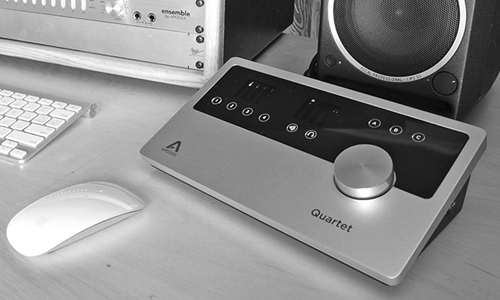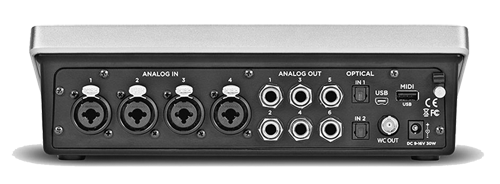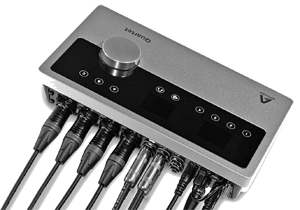by Steve Cunningham
It just so happens that I’m currently evaluating audio interfaces for use in the 25-seat Macintosh computer lab at the university where I ply my trade, and where we teach audio recording and editing using Macs and Pro Tools (as well as several other multitrack programs). We’ve used various incarnations of the Avid (nee Digidesign) mBox for nearly a decade, from the original vertical Mbox 1 up to and including the current Mbox 3. Our experience with the latter, known today as just the Mbox, has been less than satisfactory from a reliability standpoint; never mind that the newer model uses a different driver that the older models, so both drivers have to be installed and the correct one must be selected for things to go well (which they sometimes don’t with noob students). So rather than replacing the defective units while still supporting two drivers, a decision has been made to buy new. Hence this month’s review of the Apogee Quartet audio interface.
Apogee has long had a reputation for high quality audio converter boxes, designed exclusively for Macintosh computers. Their large scale Symphony I/O series of multi-input and -output interfaces have been the first choice of high-end music studios who want to upgrade Avid’s Pro Tools HD interfaces. On the other end of the price scale, the company’s Duet and One interfaces have upgraded many a desktop recording rig at a cost that while not cheap, can be considered moderate and a good value for the performance (the One was reviewed in the May 2010 issue of RAP). The Apogee Quartet occupies a comfortable middle ground between those two price categories.

WHAT IT IS
As the name suggests, the Quartet is a four-in, six-out USB audio interface for Macs only. The four combination XLR mic/quarter-in line inputs are two more than most of us use, but the extras do come in handy for external CD players and whatnot, not to mention serving as returns for external effects processors. They will sample at rates up to 192kHz with either 16 or 24 bit resolution. For those occasions when even four mic preamps are not enough, the Quartet also features two ADAT-format optical digital inputs that allow one to connect an external mic pre expander for even more mic channels, although it drops the max sample rate to 96kHz in that configuration.
The Quartet’s back panel is home to the four aforementioned combo XLR/jack inputs and two ADAT input ports, plus six analog outputs on quarter-inch TRS jacks, USB ports for connection to the host computer (plus one for MIDI, which we will ignore here), a word clock output, a ground terminal and cable clamp, and an input for the external power supply.
The Quartet’s interface consists of two color screens for metering and status display (levels, grouping, phase, muting, phantom power and Soft Limit). The leftmost QuickTouch pads are numbered one to four for input selection. Two more buttons select speaker or headphone level adjustment, and meters for all four inputs and the output levels are simultaneously visible. The single controller knob, with its integral push-switch, adjusts all the variable functions, as well as serving as a main volume control.
The aluminum wedge enclosure feels hefty and quite solid, and non-skid base is remarkably effective at keeping the unit in place even on a sloped surface. The Quartet shares the same single-knob control interface as do the Duet 2 and One units. Apogee’s signature “QuickTouch” touch pads and displays are set into a single black panel, and helps give the whole unit a clean and elegant appearance. Frankly it forced me to clean up the rest of my desk, which was shamefully cluttered with junk, just to give it a suitable environment in which to sit.
GOZINTAS AND GOZOUTAS
The Quartet has six balanced analog outputs on TRS jacks, which can be used in pairs as three stereo speaker feeds for comparison monitoring, individually for 5.1 surround out, or configured as sends to external effects devices. There’s also a separate headphone output located on the right-hand side of the case, which has full level control via the front panel, and that can be fed from its own monitor mix if desired.

The A to D and D to A conversion is performed by Apogee’s world-class conversion technology, and the designers have endeavored to provide mic preamps whose quality is suitable for the converters. Each of the digitally-controlled analog preamps behind the combination jacks offers a boatload of clean gain, from 0 to 75dB, and changing the gain is smooth and quiet with no hint of stepping. As you’d expect, 48 volt phantom power is available independently on each microphone input for condenser microphones.
Other rear-panel connections include an input for the included power supply and a word clock output on a standard BNC connector. A separate ground terminal (which is useful for grounding in laptop-based systems) also includes a cable clip for the included wall wart power supply.
 Finally, the Quartet provides a separate mini-USB jack for connecting MIDI to the a computer using the cable which is included. The regular USB port marked MIDI is designed to work only with Core MIDI devices and not for general USB functions, and I did not bother to test it with alternative MIDI controllers.
Finally, the Quartet provides a separate mini-USB jack for connecting MIDI to the a computer using the cable which is included. The regular USB port marked MIDI is designed to work only with Core MIDI devices and not for general USB functions, and I did not bother to test it with alternative MIDI controllers.
Apogee has a well-reasoned page on its web site explaining its decision to use the USB 2.0 protocol for connecting Quartet to the host computer. The basic thinking is that the existing USB 2 implementation is sufficient to handle the volume of audio data involved with the Quartet, even with several channels of 192kHz digital audio. While USB 3 offers more bandwidth, Apogee believes this would not result in any performance benefits. With the arrival of Thunderbolt, Firewire’s future is currently unclear, and Thunderbolt appears to be overkill, so Apogee has decided to stick with the universality of USB 2.0.
In fact, the company makes a big deal about the low latency that can be achieved with the Quartet: at 96kHz and at a buffer size of 32 samples, latency is just 3.6ms — a full millisecond less than an equivalent Firewire 400 setup. I used a buffer size of 64 samples at 44.1kHz for most of my tests which for all intents and purposes is latency-free, even in an overdub situation.
Also worthy of mention is Soft Limit, Apogee’s proprietary circuitry for subtly squashing the peaks of loud signals to produce a more analog-like saturation when the signal level approaches the maximum. This can be enabled or disabled on an individual channel basis via the downloadable Maestro 2 software.
GAS ON
The Quartet will work with any Core Audio compatible editor running on an Intel Mac with a 1.5GHz CPU or better. The requirements include 2GB of RAM minimum, 4GB recommended, and Mac OS 10.6.8 or higher. I checked it out with several multitracks: Pro Tools 10 (natch!), Adobe Audition for Mac, Cockos Reaper, and good old Garageband, as well as both Twisted Wave and Triumph stereo editors, and all worked quite well via Core Audio.
The Maestro 2 control software is an integral part of the package. It has a straightforward, single-window interface and is compatible with current Mac operating systems, as well as with the older Snow Leopard OS. Here you can configure the system, select the input type, enable or disable Soft Limit on the inputs, and use Maestro’s mixer section for low-latency monitoring. This is also where you would assign speakers to touch pads and configure the front-panel A, B and C buttons.
When I plugged in the Quartet, it was immediately recognized by Core Audio for basic operations, since the assignable touch pads are preconfigured to Dim, Mute and Clear Meters, with the latter clearing the red overload indicators at the top of each meter indicating that audio was clipped. However, you’ll need that Maestro control software in order to make any changes or to switch on the phantom power.
When the QuickTouch pads are used for input, output or speaker-set selection, the big controller knob adjusts the currently selected parameter. For example, if you select an input then the knob adjusts the preamp gain; if you select a speaker, it adjusts the speaker volume. An LED highlight ring appears around the currently active touch pad, so you always know which parameter you are about to adjust. The three rightmost touch pads (labeled A, B and C and located above the rotary control) are all user assignable, so you can decide what you need them to do from a menu of options shown in the Maestro software. Your choices include sum to mono, dim the levels, switch speaker sets or clear the clip indicator in the meters. As mentioned, up to three sets of stereo speakers can be connected, or all the outputs may be used individually to create a single 5.1 surround system. You can also mix and match the functionality by, for instance, having two sets of speakers connected and then using the remaining two outputs to feed an outboard processor, which you can then return via the extra two inputs (assuming you’re not already using them).
When an input’s gain is being adjusted, the meter area on the front panel changes to a gain-knob display, with further status indicators showing Grouping, Soft Limit and Polarity. Similarly, adjusting a speaker’s level shows a rotary display for the level value and a speaker symbol, although a “Home Lock” option prevents the view from changing. Once you stop turning the knob, the display automatically reverts to metering after a few seconds. The displays are easily visible, and very clear.
With the Maestro software’s Input panel open, you can also select the input type as Line +4dBu, Line -10dBv, Mic or Instrument. The appropriate symbol for each is shown above the input meters, and when a stereo recording is being made, channels can be grouped so that their gains are adjusted together. You can activate Reverse Polarity along with Soft Limit, and both are independent on each of the four inputs.
The Maestro Mixer window is where you set up low-latency monitoring, as follows. The window actually shows two mixers, one above the other, so if you need two different monitor mixes while recording, one can be assigned to feed the speakers and one the headphones. Each mixer allows you to balance any live inputs with the audio returning from your recording software. As long as you remember to turn down the monitor level of any tracks you’re currently recording in your software mixer, you will get latency-free monitoring from the Quartet.
Separate tabs open pages for viewing Inputs, Outputs, Device Settings, Output Routing, Mixer and System Setup. Device Settings is where you select what those three right-hand ABC buttons should control, and you can also set the push-switch in the rotary encoder to mute the speakers, the phones, or both.
The Quartet comes with a quick-start guide, and a comprehensive user manual that details the setup procedure for all the mainstream software packages is available from the Apogee web site. But if you’ve ever used an audio interface before, you should have no trouble finding your way around the Quartet.
HOWZIT?
The quality of Apogee’s converters is so good that even working at 44.1kHz produces smooth and clean results, with absolutely no appreciable artifacts and excellent stereo imaging. Needless to say these are a noticeable step up from Avid’s converters, and they rival the best I’ve heard. We’re now at the point of diminishing returns compared to even mastering-class converters. The mic preamps are also worthy of mention, as they are exceptionally clean and focused. There’s plenty of gain for ribbon microphones, and little noise even at +75dB of gain save for a small amount of honest active component hiss. Soft Limit is a nice touch, as it gently limits overs while imparting a slight analog tape-ish character to the limited sound.
The touch interface is so intuitive that I barely noticed the solitary big knob for adjusting everything. Integration with the Maestro software is smooth and seamless, and using it to activate phantom power, polarity-invert switches and whatnot is easy and painless.
At a US retail of $1249, the Quartet is not a cheap interface, and dealers don’t generally discount Apogee products. Some may not be willing to pay for the extra gozintas and gozoutas that are part of the package. But these are the very features that make the Quartet a good value -- for the first time in a while I find myself enthused about the possibility of setting up a surround system, and unconcerned that I no longer have a mixer as part of my recording rig. It’s that good, and Steve sez check it out.
For more information worldwide, visit http://www.apogeedigital.com/products/quartet.php.
♦

